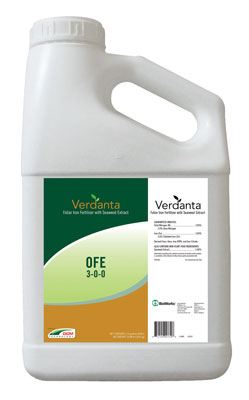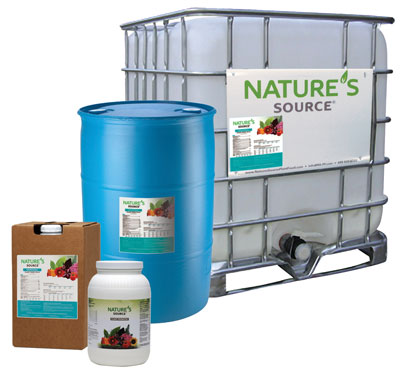2/1/2018
Good Chemistry
Allison Westbrook

It’s common to think that to grow organically, it has to be “all or nothing”—you have to use all organic fertilizer and none of the traditional stuff. But there are great benefits to be had from using a combination of both.
Also, what exactly makes a fertilizer “organic”? While it may take a bit of a learning curve, the benefits and savings of using organic fertilizer—whether you’re growing completely organic or doing a little of both—may be well worth it.
What’s organic fertilizer?
We all understand the concept of what makes food organic—grown without the use of pesticides and other chemicals—but what makes a fertilizer organic?
Mark Freeman, Biological Plant Nutrition Product Manager for BioWorks, said the key factor in categorizing fertilizer as organic is processing. A product can be organic, if it’s just dried and milled, but if it’s changed by a chemical process, it isn’t considered organic any longer. Mark gave the example of plant-derived raw materials, such as fermented molasses (vinasse), which are typically byproducts of basic milling or physical extraction of oils.
Pictured: BioWorks Verdanta OFE Liquid, a foliar iron fertilizer with seaweed extract, improves greening up of leaves without residue or burning, and corrects foliar chlorosis causes by soil pH
or heat-induced issues.
“Whether it can be called organic or not depends on the raw materials and whether the milling or extraction processes fit within the USDA National Organic Program guidelines and the organic guidelines of each of the states,” he explained. “If there is a chemical synthesis process involved, then it’s likely that it can’t truly be called ‘organic’ fertilizer in the context of organic production.”
Also, Mark said an organic fertilizer may have additives and doesn’t have to contain just one ingredient to truly be considered organic, as long as all of the additives are approved as “natural” and not processed with chemicals.
Combining the two
There can be a learning curve to using a combination of organic and synthetic fertilizer together, but it can have a big pay-off.
One benefit (and some can argue most important) is cost. Most traditional fertilizer products are expensive, especially nitrogen and potash. Using a combination allows you to use less traditional fertilizer and thus, lower your costs. There’s also less salt accumulation when you use both types, which leads to less stress on plants and less pest pressure.
But Mark says that the single biggest reason to combine is to gain nutrient efficiencies.
“Phosphorus is the best example,” he said. “Historically, it will get locked up in mineral soils. Growing in a traditional field, you have to apply lots of phosphorus, as it can be held within the soil and not available to the plant. It can also leach in peat-based or traditional mixes.”
Some granular organic fertilizers not only release phosphorous to plants as they naturally break down in the soil, Mark explained, but they also drive soil microbes to retain phosphorous from traditional fertilizers and make insoluble phosphorous already in soils available to the plants.
Chance Finch, GM of Nature’s Source, explained that another key benefit to organic fertilizer is that it doesn’t deplete or cause harm to growing media and soil.
“Synthetic feeds can build up nitrogen and phosphorus and the soil can become semi-sterile,” he said. “It also benefits the soil. That’s how you win, using the traditional side and organic side.”
Chance agrees that adding organics increases the efficiency of traditional fertilizer in the soil.
“We can take the typical application rate and reduce it as much as half and allow the nutrition applied to be more efficiently used in the plant,” he said. And this, of course, ends up saving money for the grower.
Lloyd Traven of Peace Tree Farm in Kintnersville, Pennsylvania, is a grower that’s unique in that he uses primarily organic fertilizer with an addition of synthetics, as opposed to what Chance and Mark are used to seeing. Lloyd grows both certified organic crops and non-certified crops (petunias, for example), and both use BioWorks’ Verdanta N-Vita as their primary nutrition.
However, for his non-certified crops, he uses organic nutrition along with a traditional fertilizer as a supplement for specific crop issues. This allows for targeted problem solving when there are nutrition issues, such as a shortage of iron when growing petunias. For these applications, he uses a custom Jack’s blend, put together by Cari Peters.
“We ID a problem and then tailor a supplement to it,” Lloyd says.
Getting started
So you’re thinking you’d like to take a stab at incorporating some organic growing into your production, but what’s the best way to go about it? Chance recommends doing a trial, even if it’s a small one, on just one or two benches. He says that many growers need to “see it to believe it” and a trial will do just that.
“For example, if a grower normally uses one pound of traditional nitrogen fertilizer on the crop, on the trial crop, use three-fourths of a pound of traditional fertilizer with one-fourth of organic fertilizer,” he said. “This can show the value and lead down the path of using fewer synthetics.”
Consulting an expert supplier is key, says Mark. While some growers are willing and able to make their own organic fertilizer, he suggests that beginners consult a respected and established company who can evaluate a grower’s operation and what they need to get started.
“Don’t just go down to the end of the road and get some of the by-products from your local farmer, even though it may be organic,” warned Mark. “That’s not the best place to start, especially if you are growing in containers.”
 Make sure that the supplier of your organic fertilizer is reputable and that their process is taking into account the issues that can happen with organic fertilizers, like managing nutrition (more on that later). Mark advised that you should start with an organic fertilizer source that’s well-studied, especially in containerized production.
Make sure that the supplier of your organic fertilizer is reputable and that their process is taking into account the issues that can happen with organic fertilizers, like managing nutrition (more on that later). Mark advised that you should start with an organic fertilizer source that’s well-studied, especially in containerized production.
Mark suggests that a good crop to start getting experience with using this type of fertilization is hanging baskets. One of the biggest reasons for this success is that growers have traditionally used controlled-release fertilizer in hanging basket production. Hanging baskets are usually longer crop programs, use larger volumes of soil and often have infrequent irrigation, especially if growing hanging baskets up toward the roof of a greenhouse.
Pictured: Nature’s Source Professional Plant Food 10-4-3 is a combination of traditional and organic fertilizer, and made with oilseed extract, a renewable source of plant nutrition. In addition to N-P-K, it contains Boost Molecules (amino acids), as well as calciumand magnesium to improve plantperformance.
“The system is finite on water amounts, which doesn’t lend itself well to using water-soluble or liquid forms of nutrition alone,” Mark said. In addition, controlled-release fertilizer products are expensive and replacing part of the nutrition with organic sources can save you money in inputs. Also, with organics, there’s a better utilization of resources, less loss in leaching and less fertilizer going to runoff.
Challenges and concerns
As with all fertilizer programs, this route isn’t without its challenges. First, as with anything you try for the first time, there’s going to be a learning curve. Fortunately, there are many avenues for help and education. Universities and suppliers have a wealth of information on the topic, and a supplier can help tailor a solution to your operation. You can also reach out to another grower you know who’s using organic fertilizers and glean what they’ve learned during their trials and experiences.
You may also be concerned with using a new fertilizer in your existing IPM program; however, both of the suppliers we talked to said that they test their products to ensure safety with beneficials and will help you develop a program that fits into pest program.
Mark states that the biggest challenge that comes up with organic nutrition is the management of pH and EC because “you are not dealing with straight chemistry. Synthetic is basic chemistry. That history is pretty solid; growers have been doing it for 50-plus years.”
He added, “With organic, depending on how you combine it, you can create issues with your pH and EC, if not taking into account how they interact with water and soil.”
This can be avoided by working with a supplier or with university support that understands what the products will do within your water and soil.
Lloyd says that organic fertilizer has its challenges, especially when it comes to organic greenhouse production. In field production, a grower has the luxury of time, he explains, and they can build up their soil fertility over the years with cover crops.
Says Lloyd, “In greenhouse production, the crop cycle is usually rather rapid and the growth rate is also faster. The fertility and biology need to be there and available from the start because there’s not enough time to build the soil biology completely and create enough sustainable fertility to last throughout the entire crop cycle.”
Even with a bit of a learning curve, the benefits gained can be worth the time taken to understand and implement a combination of traditional and organic fertilizers. Not only will a grower save time and money, the health of the soil will improve and with healthier plants comes less disease and pest pressure. There are many sources of information from suppliers and educators to help you get started, so don’t be afraid to take the plunge and give organic fertilizer a try with your existing program. GT